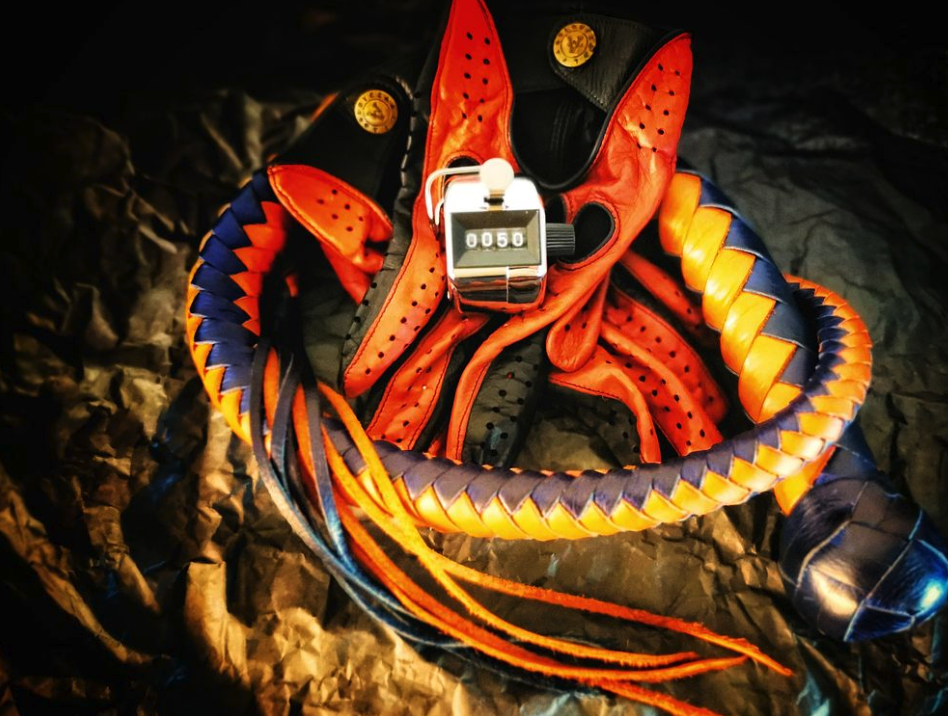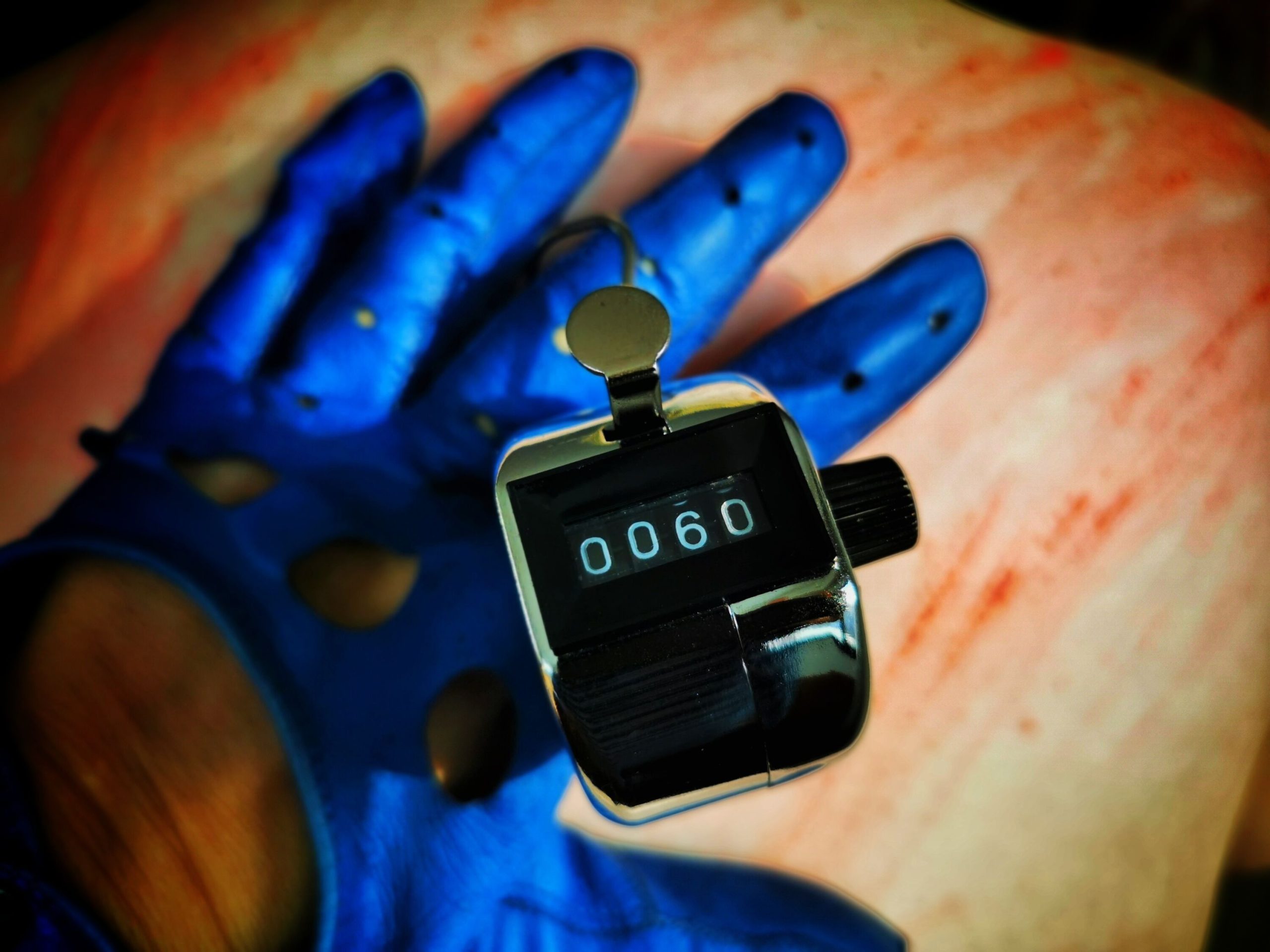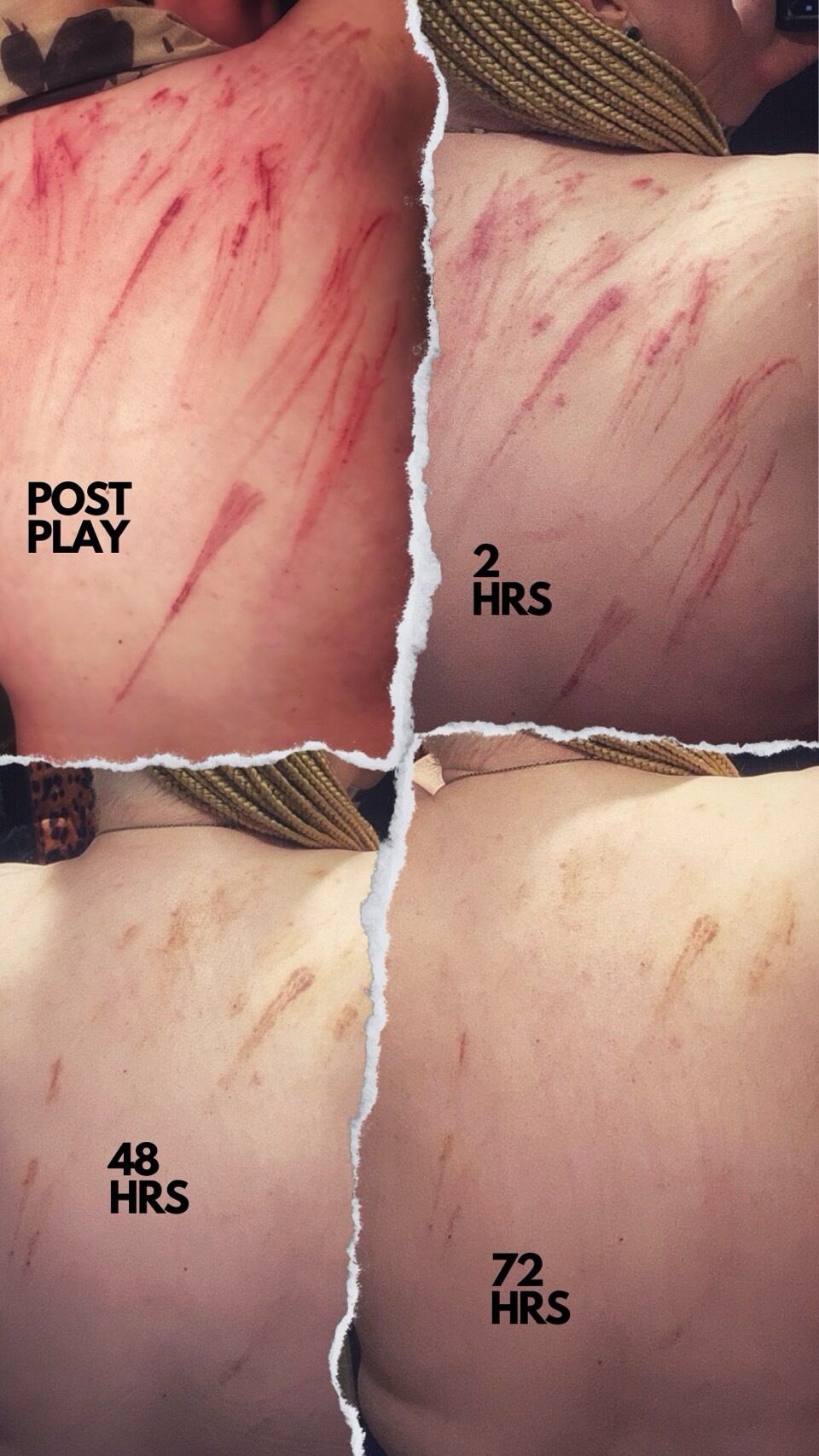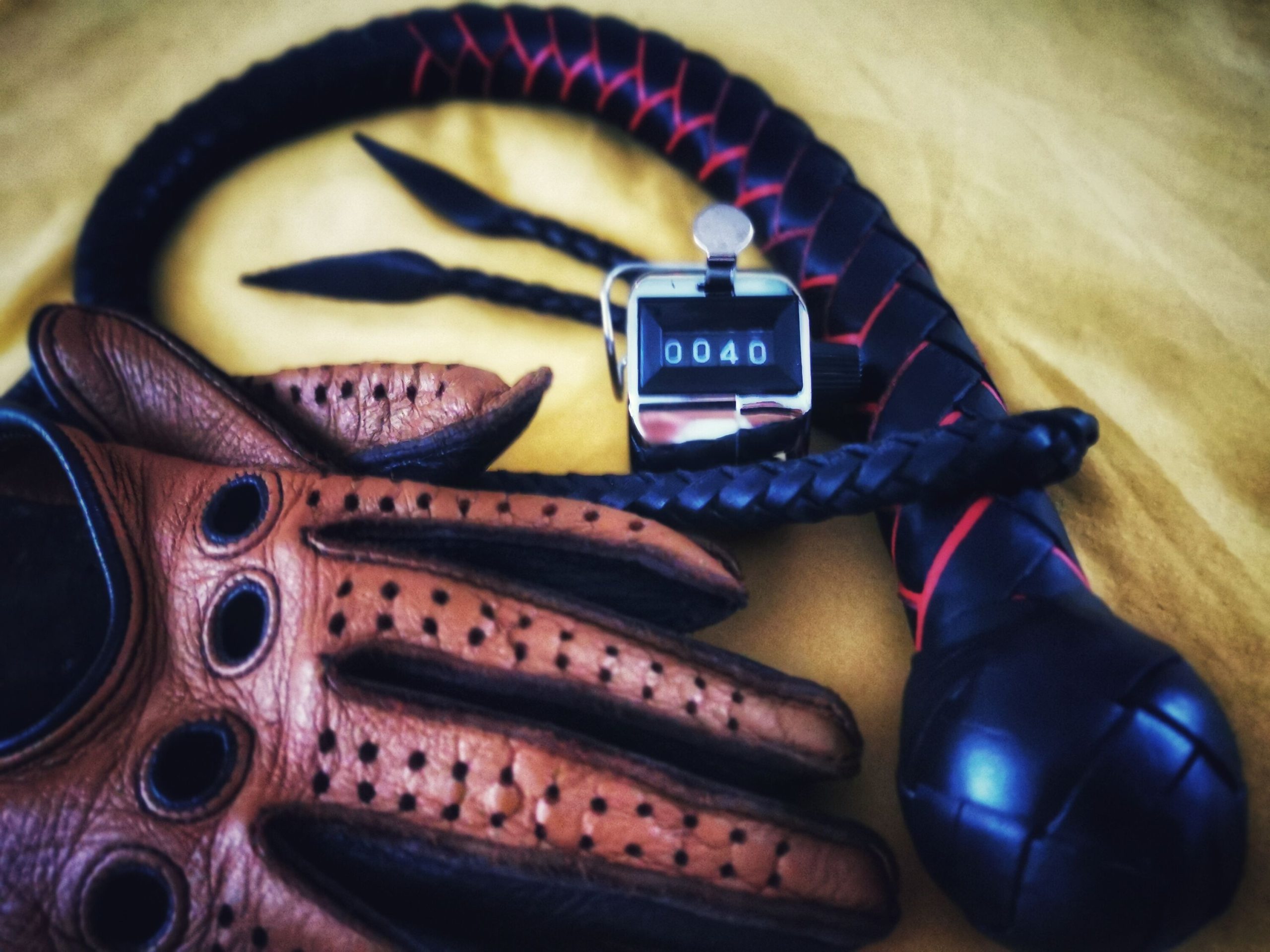Calibration methods in impact play are crucial for ensuring safety, comfort, and mutual satisfaction. They can help align the experiences and boundaries of all parties involved, especially when exploring various levels of sensation, pain, intensity, and play types. Here are some effective calibration techniques to choose or combine:
1. The Traffic Light System
This is the most basic, simple and effective way to communicate intensity and boundaries without breaking the flow of the scene.
– Green: Indicates everything is good, and the bottom is comfortable. It can mean “keep going” or even “you can increase intensity.” Regular check-ins, such as “Are we still green?” or “What colour are we now?” help maintain open communication.
– Yellow: Signals that the bottom is nearing their comfort threshold, and adjustments should be made. This could mean reducing intensity, changing techniques, or slowing down.
– Red:
A full stop, meaning the bottom needs an immediate halt. There’s no ambiguity with red — it signals that the play needs to stop, and the bottom might need aftercare or to debrief about what happened.
It is important to clearly define and respect the meanings of “red” and “yellow” signals. “Red” means to stop everything immediately, without questioning, while “yellow” signals a need for reassessment, not to be taken lightly. Knowing that their signals will be respected gives bottoms confidence, reducing anxiety around having to communicate discomfort.
2. Pain Scale Calibration
This method uses a numeric scale, typically 1 to 10, to rate the sensation’s intensity.
– Scale Setup: Before starting, the top and bottom discuss acceptable pain levels. For example, a bottom might say that they prefer the pain to stay within a 3–5 range, where 1 is light and comfortable, and 10 is intolerable.
– Real-Time Feedback: Throughout the play, the top can ask, “What’s your number?” to check the bottom’s comfort level. The bottom’s response helps the top gauge if they should intensify or ease off.
– Adjusting Levels: If the bottom signals they’re at their upper limit (e.g., 7–8), the top knows to avoid going further. This scale gives a concrete measure to communicate pain, especially useful if verbal expressions like “a bit harder” are too vague or subjective.
The use of a 1–10 scale is a prime example of dynamic communication. It encourages bottoms to specify their level of discomfort, which allows the top to adjust intensity. This method also builds trust, as it prevents the bottom from having to endure excessive discomfort before calling “red”.
I personally enjoy using this method in my impact practice sessions. If you’re fortunate enough to work with a bottom who can remain present throughout the session, you can ask them to rate each stroke, even using smaller increments for more precise feedback (e.g., 4.5 or 4.75). If possible, encourage them to describe the sensation of each strike (e.g., 4.5 feels stingy, while 4.75 feels heavy and punchy). This approach is an amazing way to deepen your understanding of how to control your tools and the most effective and nuanced ways to throw them.
3. Gradual Progression and Check-Ins
Gradual progression involves slowly building up the intensity of impact to allow the bottom to process pain and adjust to assess their limits.
– Starting Light: Begin with low-impact, gentle strikes or touches, and progressively increase intensity. This gives the bottom time to adjust and find their comfort zone.
– Midway Check-Ins: Periodic check-ins like, “Is this pace okay?” or “How’s the intensity?” give the bottom a chance to recalibrate. They may respond with “yes” to continue, or they may need to have a break or go down in intensity.
– Dynamic Adjustment: If the bottom is comfortable, the top may continue increasing intensity. If the bottom expresses discomfort, the top can adjust on the fly, keeping the experience enjoyable.
Regular check-ins help avoid discomfort from building up. Tops can gently remind bottoms not to endure beyond comfort for the sake of appearing “strong.” This approach minimises the risk of accidentally overwhelming the bottom, as their tolerance and comfort are monitored consistently.
4. Negotiated Boundaries and Specific Language
Negotiating boundaries before the session begins is vital for safe and enjoyable play.
– Clear Descriptors: Define terms like “light,” “medium,” and “hard” to create a shared language. For instance, “medium” could mean a certain level of impact for one person, but a stronger force for another. Clarifying these terms reduces ambiguity.
– Preset Limits: Agree on specific do’s and don’ts, such as, “Avoid face and neck” or “Keep it below a level 5 intensity.” Having concrete boundaries in place establishes mutual understanding and prevents accidental discomfort.
– Special Codes and Words: Some pairs use unique codes or words to indicate a particular request, like “switch” to change the tool or area, or “pause” for a short break without ending the session. Putting your personal touches can ensure clarity and precise communication.
5. Implement Calibration
Impact play tools (e.g., floggers, paddles, canes) each produce different sensations and intensities. By calibrating based on specific implements, we can adjust accordingly:
– Sensitivity by Tool: A bottom might be comfortable with a flogger but not with a cane. Discussing each implement’s sensation helps set expectations for comfort zones. For example, “Light flogging on the back is okay, but only gentle tapping with a paddle on the feet.”
– Tool-Specific Limits: Before the session, the top and bottom can agree on acceptable limits for each tool. For instance, “Light paddle strikes only,” or “Medium flogger strokes are fine on my shoulders.”
– Experimentation and Feedback: If trying a new tool, starting with light, exploratory taps or light strikes can help gauge tolerance. Feedback from the bottom will guide how much or how little force to apply.
This method allows for play that suits the bottom’s comfort with each specific tool, making the experience safer and more enjoyable.
6. Body Mapping
Body mapping involves identifying areas of the body where the bottom is comfortable with impact and those they prefer to avoid:
– Establishing Zones: Some areas, like thighs and shoulders, are often more resilient, while others (like the spine or face) may be more sensitive. By mapping out zones in advance, both parties know where impact is welcome and where it’s not.
– Sensitive Area Notes: Bottoms can mark certain areas as “off-limits” or “light only,” allowing the top to adjust intensity based on each zone’s tolerance level.
– Visual Maps or Verbal Agreements: Some people create a visual body map to mark preferred impact areas, while others verbally indicate “yes” and “no” zones. Either way, body mapping sets clear boundaries, so the top can apply appropriate force and avoid or target sensitive spots.
Areas to Avoid
– Major Organs: Avoid the tummy, lower back, and any areas over internal organs such as the kidneys and liver.
– Spine and Tailbone: The spine, including the tailbone, should never be targeted due to the risk of serious injury.
– Ears, Head, and Face: While face-slapping can be done, it must be done very carefully to avoid damaging the ears or eyes. The neck is also a high-risk area due to its sensitive anatomy.
– Joints and Bony Areas: Avoid hitting joints, elbows, armpits, wrists, and the Achilles tendon as these areas are highly susceptible to injury.
– Calves and Feet: These areas are generally considered high risk areas due to their lack of padding and the risk of injury.
This method allows for a more nuanced approach, respecting individual body preferences and sensitivities.
7. Baseline and Warm-Up Techniques
Warming up the body with light, steady impact helps the bottom adapt to sensation, minimising the risk of sudden discomfort:
– Light Touch Start: Begin with a series of gentle, rhythmic taps to help the bottom adjust and signal they are ready for more.
– Progressive Intensity: Gradually increase intensity as the bottom feels comfortable, working up to desired levels. This allows the body to release endorphins gradually, which can heighten tolerance to impact.
– Build-Up Duration: Taking time with the warm-up phase prepares the body, ensuring smoother and more enjoyable transitions to higher intensity levels.
This technique respects the body’s natural adaptation, creating a safe environment to explore stronger sensations as comfort allows.
10-Minute / 10 Strike Rule
Periodically relieving the bottom from stress, checking in or allowing a brief break, especially during intense scenes, can build the bottom’s endurance and comfort while reducing the risk of fatigue or unintended strain.
8. Personalised Feedback Signals
Custom signals, hand gestures, or phrases can communicate specific needs and preferences without interrupting the scene’s flow:
– Unique Signals: Personalised cues, such as hand squeezes, taps, or specific words like “feather” for softer impact, give the bottom a way to communicate without breaking immersion.
– Custom Safe Words: Beyond standard safe words, some partners create unique signals for particular requests, like “cool” for breaks or “move” to change the impact area.
– Visual Signals: For scenes where verbal communication may not be practical, visual signals (like nodding, hand waving, foot tapping) can serve as real-time indicators of comfort and readiness or discomfort.
9. Post-Play Reflection and Calibration
Debriefing after a session allows participants to discuss what worked, what didn’t, and what could be adjusted for future play:
– Detailed Feedback: Both parties can share specific likes, dislikes, and comfort levels, improving understanding for next time.
– Exploring Boundaries: If certain aspects were uncomfortable, participants can note these for future adjustments.
– Positive Reinforcement: Highlighting enjoyable parts of the session builds trust and makes it easier to explore further.
Reflection Encouragement
Post-session feedback allows both partners to discuss what worked and what didn’t. This debriefing helps each person understand boundaries and preferences more deeply, fostering a stronger connection and enhancing future sessions. Both need to make sure to create safe environment for this type of open and judgement free communication.
10. Breath and Body Language Monitoring
Observing non-verbal cues helps the top assess comfort without needing verbal confirmation:
– Breathing Patterns: Rapid or shallow breaths can indicate discomfort, while deep, relaxed breathing suggests comfort. Observing this helps the top adjust intensity.
– Muscle Tension: Tensing muscles may signal pain or discomfort, whereas relaxed muscles usually indicate ease and enjoyment.
– Eye Contact and Expressions: If eye contact is comfortable, it can offer immediate feedback. Changes in facial expressions or vocal sounds (like sighs) provide valuable insights.
11. Examples of Calibration for Different Types of Toys and Implements
Different implements require different calibration techniques due to their unique characteristics and the sensations they produce.
Hands and Fists
– Calibration: Start with light slaps using an open hand and gradually increase the intensity based on feedback. For punching, use a loose fist and hit with the flat part of the fingers, not the knuckles.
– Technique Example: Experiment with overhand, underhand, and side-to-side swings. For slapping the face, aim for the fullest part of the cheek, avoiding the nose, eyes, and ears.
Paddles and Slappers
– Calibration: Start with lighter taps and slaps and gradually move to more intense ones based on the bottom’s feedback. Use a pain scale to gauge the intensity and adjust accordingly.
– Technique Example: Aim for the “sweet spot” on the buttocks; hit the upper part of the back of the thighs more gently.
Floggers and Whips
– Calibration: Begin with light strikes and build up intensity based on the bottom’s feedback. Use a pain scale to calibrate the intensity, ensuring to stay within the agreed-upon limits.
– Technique Example: Ensure to control the distance, speed and force of the strikes to avoid unintended wrapping, cutting or permanent harm. Pay attention to your wrist work.
Canes
– Calibration: Canes are very intense and require careful calibration. Start with light taps and build up gradually, ensuring the bottom is comfortable with each increase in intensity.
– Technique Example: Aim for well-padded areas like the buttocks, avoiding exposed bones and joints. Each stroke should be precise and controlled, escalating from light to more intense throughout the scene.
12. Calibration Affected by Different Positions
The position of the bottom can significantly affect the calibration of impact play.
Over-the-Knee (OTK) Position
In this position, the top may not see the bottom’s facial expressions clearly, making verbal feedback and safe words crucial.
Bound or Restrained Positions
When the bottom is bound or restrained, they may be more vulnerable and less able to move away from the impact. Ensure the restraints are secure but not too tight, and keep safety scissors handy.
Standing or Kneeling Positions
These positions allow for more mobility and require the top to be precise in targeting.
P.S.
As per usual, there is no right or wrong way to do any of it. Hope these tips can help you better understand different aspects of impact and what to pay attention to, and give you tools to come up with your own way that works for you and your partner(s).






